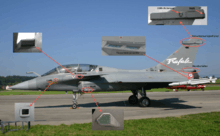Thales Spectra

SPECTRA (Système de Protection et d'Évitement des Conduites de Tir du Rafale (literally: System of Protection and Avoidance of enemy Fire-Control for Rafale) or "Self-Protection Equipment Countering Threats to Rafale Aircraft") was jointly developed by Thales Group and MBDA for the Dassault Rafale fighter aircraft, now in service with the French Air Force and Navy.
The full SPECTRA integrated electronic warfare suite provides long-range detection, identification and accurate localisation of infrared homing, radio frequency and laser threats. The system incorporates radar warning receiver, laser warning and Missile Approach Warning for threat detection plus a phased array radar jammer and a decoy dispenser for threat countering.[1] It also includes a dedicated management unit for data fusion and reaction decision.
The SPECTRA system consists of two infrared missile warning sensors (Détecteur de Départ Missile Nouvelle Génération). A new generation missile warning system (DDM NG) is currently being developed by MBDA. The DDM NG delivered its first in flight images in March 2010 and will be available on the Rafale from 2012. DDM NG incorporates a new infrared array detector which enhances performance with regard to the range at which a missile firing will be detected (with two sensors, each equipped with a fish-eye lens, DDM NG provides a spherical field of view around the aircraft). The DDM-NG also offers improved rejection of false alarms and gives an angular localisation capability which will be compatible with the future use of Directional Infrared Counter Measures (DIRCM).[2]
Thales Group and Dassault Aviation have mentioned stealthy jamming modes for the SPECTRA system, to reduce the aircraft's apparent radar signature. It is not known exactly how these work or even if the capability is fully operational, but it may employ active cancellation technology, such as has been tested by Thales and MBDA. Active cancellation is supposed to work by sampling and analysing incoming radar and feeding it back to the hostile emitter out of phase thus cancelling out the returning radar echo.[3]
References
- ↑ http://www.mbda-systems.com/mediagallery/files/spectra_ds.pdf
- ↑ http://www.mbda-systems.com/mediagallery/files/ddm_ng_ds.pdf
- ↑ Sweetman, Bill A Stealthier Rafale? Ares Defense Technology Blog, 5 April 2010